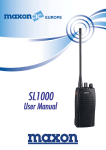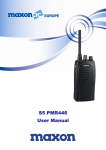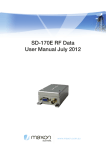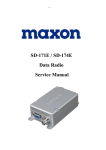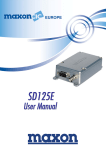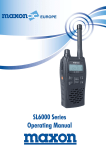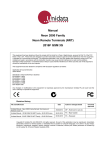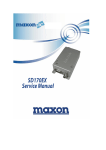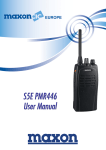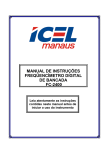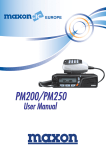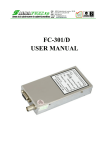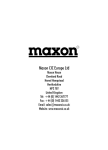Download English
Transcript
SD170E Series Safety Information WARNING ¾ NEVER connect the transceiver to an AC outlet. This may pose a fire hazard or result in an electric shock. ¾ NEVER operate the radio transmitter without a suitable artificial load or antenna connected ¾ DO NOT allows children to operate transmitter-equipped radio equipment. CAUTION ¾ DO NOT operates the transceiver near unshielded electrical blasting caps or in an explosive atmosphere unless it is a type especially designed and qualified for such use. ¾ NEVER modify a transceiver or accessory except as instructed in the service manual, engineering bulletins or formal communication as this may invalidate any warranty, guarantee or type approval. ¾ NEVER use the transceiver in an aircraft. ¾ NEVER use the transceiver near to sensitive medical equipment or in areas where instructed not to do so, e.g. Petrol filling stations. ¾ NEVER mount the transceiver unit on or near the Airbag or Airbag activation device. ¾ NEVER use an accessory not recommended or supplied by Maxon may cause damage to equipment or injury to personnel, and will invalidate warranty. ¾ DO NOT use or place the transceiver in areas with temperatures below -30°C or above +60°C, In areas subject to direct sunlight, such as the dashboard. ¾ AVOID placing the transceiver in excessively dusty environments. ¾ DO NOT fit the transceiver in such a manner that the antenna is next to, or touching, exposed parts of the body, especially the face or eyes, while transmitting. ¾ ALWAYS Install the SD170E using a suitable heat sinking surface. ¾ NEVER operate the radio transmitter without a suitable artificial load or antenna connected. ¾ ALWAYS Secure locking nuts on DB09 connector and always disconnect power supply before removing D-type connector. For service or repair always return your radio to an authorised Maxon Dealer or warranty conditions will be invalid. Page 2 English User Manual SD170E Series Table of Contents Safety Information ................................................................................................................2 Table of Contents .................................................................................................................2 About your SD170E Series data radio......................................................................................4 About Your SD170E Radio .............................................................................................4 General SD170E Specification.................................................................................................4 SD170E Transmitter Specification ...........................................................................................5 SD170E Receiver Specification ...............................................................................................6 Unpacking Information ..........................................................................................................7 SD170E Features ..................................................................................................................7 Description of Radio Components ...........................................................................................8 SD-170E Series Operation ......................................................................................................9 Channel dip switch chart...................................................................................................... 11 Serial Command ................................................................................................................. 11 Data Protocol...................................................................................................................... 12 Serial Commands ................................................................................................................ 13 Audible alert tones .............................................................................................................. 14 Modem option for data commmunication .............................................................................. 17 ACC-515E GPS Option board ................................................................................................ 18 ACC-514E FFSK Option board ............................................................................................... 19 ACC-513E GMSK Option board ............................................................................................. 20 User Statement ................................................................................................................... 21 Page 3 English User Manual SD170E Series About your SD170E Series data radio About Your SD170 Radio The SD-170E Series of RF Link Modules utilize the latest technology in their designs and manufacturing. SD-170E models are Phase Lock Loop Synthesizer (PLL)/microprocessor controlled, and offers 1/ 5 watt (Low/High) programmable output power with 16-channel capability. Multiple functions including 1200 to 9600 baud rates, AC and/or DC audio coupling, in these fully programmable RF Link Module units, to use FSK GMSK and FFSK modulation optional boards are provided. Programmable sub-audio squelch system (CTCSS & DCS) and two-tone squelch system are added to the signal level detect squelch system (RSSI). GPS Data handling is provided to interface and control an internal GPS receiver (optional board). To assure satisfaction from the radio, we urge you to thoroughly read the operation and function information in this manual before operating your SD-171E/SD-174E. Applications of some of the functions described in this manual are determined by the system you use. Your dealer will program your radio so that you have the greatest number of functions possible relative to your needs. Should you have questions regarding the operation of the radio, please consult your Dealer. General SD170E Specification General specification Equipment Type Model Series Performance Specifications Frequency Range RF Output Channel Spacing Modulation Type Intermediate Frequency Number of Channels Frequency Source Operation Rating Power Supply Temperature Range VHF UHF Data radio (Wireless Data radio (Wireless Modem) Modem) SD-171E SD-174E TIA/EIA-603 /ETS 300TIA/EIA-603 /ETS 300-113 113 146-174MHz 450-490MHz 1-5W 1-5W 12.5KHz, 25KHz Programmable F3D, F3E 45.1MHz & 455KHz 16 Synthesizer Intermittent 90 : 5 : 5 (Standby : RX : TX) Ext. Power Supply (12 VDC Nominal) Storage From -40°C to +80°C Operating From -30°C to +60°C Current Consumption Standby(Muted) < 65mA Transmit 5Watts RF Power < 2.0 A Transmit 2Watts RF Power Lock Time : TX to RX attack time RX to TX attack time Dimensions Weight < 1.0 A < 10ms < 20ms (No Power Saving) < 20ms (118mm)W X (63mm)H X (35mm)D 266.5grams Page 4 English User Manual User Manual SD170E Series SD170E Transmitter Specification Transmitter specification Carrier Power (Nom. Max. Min.) Hi Power Low Power Sustained Transmission Time 5 10 30Sec (Nominal Conditions) Frequency Error Nominal condition Extreme condition Frequency Deviation 25 KHz Channel Spacing 12.5 KHz Channel Spacing Audio Frequency Response Adjacent Channel Power 25 KHz Channel Spacing 12.5 KHz Channel Spacing Conducted Spurious Emission Modulation Sensitivity Hum & Noise : 25 KHz Channel Spacing 12.5 KHz Channel Spacing Modulation Symmetry Load Stability Peak Deviation Range Adjustment @ 1 KHz, Nom Dev + 20dB 25 KHz Channel Spacing 12.5 KHz Channel Spacing Page 5 VHF UHF 5W < 6W > 4.5W 1W<1.5W>0.8W 5W < 6W > 4.5W 1W<1.5W>0.8W Power : >90% >85% >80% Power : >90% >85% >80% < 0.5 KHz ±2.5 ppm < 0.75 KHz ±2.5 ppm Peak ±5.0, Min. ±3.8KHz Peak ±2.5, Min. ±1.9KHz Within +1/-3dB of 6dB octave @ 300 Hz to 2.55 kHz for 12.5 kHz C.S. @ 300 Hz to 3.0 kHz for 25 kHz C.S. < 70 dBc @ Nominal Condition , < 65 dBc @ Extreme Condition < 60 dBc @ Nominal Condition , < 55 dBc @ Extreme Condition < -36 dBm < -36 dBm 100mV RMS @ 60% Peak Dev. > 40 dB (without PSOPH) > 40 dB (with PSOPH) < 10% Peak Dev @ 1KHz input for nominal dev. + 20dB No osc at ≥ 10:1 VSWR all phase angles and suitable antenna No destroy at ≥ 20:1 all phase angle Min. 3.5, Max. 6.0 Min. 1.5, Max. 4.0 User Manual SD170E Series SD170E Receiver Specification Receiver Specification Sensitivity (@ 12dB SINAD) 25 KHz Channel Spacing 12.5 KHz Channel Spacing Sensitivity ( 1/100 Error Rate) With ACC-513 With ACC-514 Amplitude Characteristic Adjacent Channel Selectivity 25 KHz Channel Spacing(Nom.) (Extreme Condition) 12.5 KHz Channel Spacing(Nom.) (Extreme Condition) Spurious Rejection(100KHz ~ 4GHz) Image / Half IF Rejection Intermodulation Response Rejection ±25 kHz/ 50 kHz ±50 kHz/ 100 kHz Conducted Spurious Emission 9 KHz - 1 GHz 1 GHz – 4 GHz RX Spurious Emissions (Radiated) 9 KHz - 1 GHz 1 GHz – 4 GHz AF Distortion Nominal condition Extreme condition RX Hum & Noise (only audio) 25 KHz Channel Spacing 12.5 KHz Channel Spacing Receiver Response Time : Squelch (factory pre-set) Open Close Squelch Attack Time RF Level at Threshold RF Level at Threshold + 20dB Squelch Decay Time Antenna Socket Input Match Temperature Stability for L.O. Frequency L.O. Frequency Aging Rate Page 6 VHF UHF < 0.28uV < 0.30uV < 0.28uV < 0.30uV < -113dBm < -110dBm < -113dBm < -110dBm > -3dB , < +3dB > -3dB , < +3dB > > > > > 70 60 65 50 70 dB dB dB dB dB > > > > > 70 60 65 50 70 dB dB dB dB dB > 70 dB > 70 dB > 70 dB > 70 dB > 70 dB > 70 dB < -57 dBm < -47 dBm < -57 dBm < -47 dBm < -57 dBm < -47 dBm < -57 dBm < -47 dBm < 3% < 10% < 3% < 10% < 40 dB without PSOPH < 40 dB with PSOPH < 16 ms < 40 dB without PSOPH < 40 dB with PSOPH < 16 ms -113dBm -116dBm < 20 ms (RSSI), < 40 ms (Analog) < 10 ms (RSSI), < 30 ms (Analog) 5 ms Min., 20ms Max. > 10 dB Return Loss 1st < 5 ppm, 2nd < 15 ppm from -30° to + 60° C ±2 ppm/ year SD170E Series Unpacking Information Remove and carefully inspect the contents of your package(s) for the following items: 1. Radio 2. User Manual * If any items are missing or damaged please contact your Dealer or Maxon Compatible accessory list (sold separate) ACC-513E 9600 baud GMSK modem ACC-514E 4800 baud FFSK modem ACC – FSK2 1200 Baud FSK modem ACC-515E GPS optional board ACC-516 PCB Interface - used to separate digital and RF board for alignment ACC-916E Personality programming software ACC-2016E Individual USB programming cable SD170E Features Synthesized Operation with 16 channel capability 1 / 5 Watt programmable output power Programmable 12.5 / 25 KHz channel spacing Channel scan Busy channel lockout 16 channel RSSI Level check TX Time-out timer Power Save Marked Idle TX Delay Dumb mode Data transmission and reception through FSK modem (Optional Board) Data transmission and reception through GMSK modem (Optional Board) Data transmission and reception through FFSK modem (Optional Board) Support transmission of global position data using GPS receiver board (Optional Board) Page 7 English User Manual SD170E Series Description of Radio Components 1) Antenna connector 2) DB-15 connector 3) GPS Antenna connector (optional) 4) Channel DIP-S/W 5) Jumper selector (see configuration below right). Exterior View CON407 Jumper Settings. Antenna installation Fasten the antenna to the radio by turning the antenna cable clockwise onto the BNC receptacle on left of radio when looking at front of radio. Programming Programming the SD170E series uses the ACC-916E programmer. Page 8 English User Manual SD170E Series SD-170E Series Operation Channel select / SCAN Your radio’s channel can be selected by inner DIP-S/W or serial command inputted from external control system. To change channel by inner DIP-S/W (4), you should open the upper cover and then look for the DIP-S/W (4) on the digital board of the bottom cover. Once located change the DIP-S/W to select wanted channel according to channel dip switch chart (see channel chart on page 11). To use a serial command for channel selection, it should be inputted by external equipment or device (ex. Personal computer or PLC) through Pin 8 of DB-15 connector. See the message format for serial command for full details. If your radio has been programmed the channel scan, you must enter the scan mode by serial command. Transmit The transmission will be made by various inputs such as PTT signal (Pin 3 of DB-15 connector), TX serial command and Serial data input (Pin 10 of DB-15 connector: This input is only available when a modem option board is installed). TTL level is used as PTT signal and is active low. If you installed an option modem board, you can use RS-232 level as a PTT signal instead of TTL level. To maintain transmission, continuous PTT signal input is required. If you use TX serial command for transmission, normally, it’s released by Rx serial command. If RF activity is present; it will not be illuminated if the radio indicates a “clear” channel. When the channel is “clear”, input the PTT signal or TX serial command and transmit data or audio. Remove the PTT signal or input Rx serial command when you have finished transmission. CAUTION: Operation of the transmitter without a proper antenna installed may result in permanent damage to the radio. Receive When you have finished transmission, remove the PTT signal or input Rx serial command. You will receive data from another radio or hear another person talking from the connected external speaker. Page 9 English User Manual SD170E Series Scan modes Scanning is a dealer programmable feature that allows you to monitor a number of channels. Your dealer will help you define a scanning mode and your channel “scan list” Channel scan Once the scan list has been established, initiate scan by serial commands. If a conversation is detected on any of the channels in the scan list, the radio will stop on that channel and you will be able to hear the conversation. At that time, busy channel data is sent to external equipment or device through serial command. So, you can identify busy channel data as decoding of received serial command from your radio in the external equipment or device. Normally, if you try to transmit during scanning, the transmission will be made on the channel that the call was received during the programmable scan delay time. The scan delay time is the amount of time the radio will stay on that channel once activity has ceased. Dealer programming of 4 ~ 7 seconds is typical). The radio will resume scanning once the scan delay time has expired, and will continue to scan until the serial command for scan stop is inputted by external equipment. After the scan resumes, if a transmission is made, the radio will transmit on the selected priority channel. This feature is similar to priority scan TX except for selection of priority channel. You can assign a priority channel by inner dip switch only. Scan channel delete To temporarily delete a channel from the scan list, simply input the serial command for scan deletion to the radio while scanning and stopped on the channel to be deleted. This will temporarily remove that channel from the scan list until the scan is closed or the radio’s power is reset. CTCSS / DCS Scanning To help to block out unwanted calls to your radio, the SD-170E series can be programmed by your dealer to scan for tones. Page 10 English User Manual SD170E Series Channel dip switch chart Serial Command Serial RX/TX Data Format (1) (2) (3) (4) (5) Asynchronous Serial Data Transfer Baud Rate : 4,800 bit/sec Data Bit : 8bit , Non Parity Stop Bit : 1bit MSB first transmission Each serial command is consist of 3 bytes. 1st byte is command and 2nd is data required by command and 3rd is check sum to decide validity of total contents. Byte0 ST 1st Byte (Command) SP Byte1 ST 2nd Byte (Data) SP Byte2 ST 3rd Byte (Check Sum) SP Page 11 English User Manual SD170E Series Data Protocol Protocol for input Serial command Protocol of data transmission from external equipment or device (: PC) to radio: External equipment or device Radio Input serial command Response Receive response Protocol for output data Protocol of data transmission from radio to external equipment or device (: PC) External equipment or device Radio Output Data Receive Data (with command) Output Data Receive Data Page 12 (with command) English User Manual SD170E Series Serial Commands Transmit Command & data Mode Channel Change RTX Mode Send. Transmit Command (BYTE0) 0x64 0x61 From PC To Radio 0x62 From Radio To Pc 0x66 Error Message 0x65 Control of GPS Power 0x6a Control of GPS Data 0x63 Scan Mode GPS mode 0x75 Modem test mode GMSK Modem alignment mode Page 13 0x7a 0x7c FFSK 0x7e Transmit data (BYTE1) 0x?? :Current channel R(0x72) : Rx mode T(0x74) : TX mode F(0x46) : Scan Stop S(0x73) : Scan Start O(0x4F) : Scan Delete 0x00 : 1 Channel 0x01 : 2 Channel 0x02 : 3 Channel 0x0f : 16 Channel Check sum (BYTE2) Transmit Command + data ( 0x64 + Channel ) ( ( ( ( ( 0x61+0x72 ) 0x61+ 0x74 ) 0x62+ 0x46 ) 0x62+ 0x73 ) 0x62+ 0x4F ) 0x66 + 0x00 0x66 + 0x01 *Only for Unmute Channel, Correct Call Channel z It occurs when Scan Delete command comes except for Busy/Correct Call z It occurs when PTT key is pushed except for Busy/Correct Call. z It occurrs when channel change command exists during Scanning. 0x00 : GPS Power ( 0x6a + 0x00 ) Off ( 0x6a + 0x01 ) 0x01 : GPS Power On 0x00 : GPS Data ( 0x63 + 0x00 ) Disable ( 0x63 + 0x01 ) 0x01 : Release GPS Data ( 0x63 + 0x02 ) to DB-15 0x02 : Release GPS Data to Modem 0x78 : Enable test ( 0x75 + 0x78 ) data ( 0x75 + 0x79 ) 0x79 : Disable test data 0x00 : Disable ( 0x7a + 0x00 ) 0x01 : Enable ( 0x7a + 0x01 ) 0x00 : Disable ( 0x7c + 0x00 ) 0x01 : Enable Mark ( 0x7c + 0x01 ) data 0x00 : Disable ( 0x7e + 0x00 ) 0x01 : Enable Space ( 0x7e + 0x01 ) data English User Manual SD170E Series Receive Command & data Mode Process Complete Commands Transmit Command (BYTE0) 0xaa 0x55 Transmit data ( BYTE1 ) Check sum( BYTE2 ) : Transmit Command + data ACK NACK Note) This command is return signal for receiving command. If Byte2 and sum of Byte0 and Byte1 among received data are same, Radio would send ACK data and execute command. If not, Radio sends Nack data. User would go into next step if receives ACK data. If user receives Nack data, user should send command again. Example: If user changes from 1st Channel to 2nd Channel, User should send Channel Change Command (0x64, 0x02, (0x64 + 0x2)) to Radio. If Byte2 and sum of Byte0 and Byte1 among received data are same, Radio sends ACK data to user and changes to 2nd channel. If not, Radio would send Nack data. Audible alert tones Your SD-170E series data radio has a sophisticated microprocessor control which provides a range of audible tone. If you connect the Speaker filtered OUT (Pin 9 of DB-15 connector) to an external speaker, you can hear audible tones at the following conditions: • Attempt to transmit on a channel that is already in use when busy channel lockout has been programmed into the radio • Transmission time has exceeded time-out timer programmed length • When the other group or people finished transmission using repeater See the status audible alert tones chart for full details. Status Warning Page 14 Description Audible tone Busy Channel lockout Single Beep Tone Before 5S T-O-T Single Beep Tone Transmit Hang on time Single Beep Tone English User Manual SD170E Series DB 15 PIN descriptions with input/output level D-Type Pin No. Function Description 1 Data modulation IN (TX Mod) Signal is directly injected to MOD through data low pass filter without pre-emphasis. 2 Data unfiltered OUT (RX disc) Discriminator audio from the SD170E. This is the unprocessed AF signal prior to tone filtering and de-emphasis. 3 PTT In (TX Key) 4 Power 5 Serial Data Out (TXD) Busy (CD) 6 Signal from the ‘external device’ to key the SD-170E transmitter. This line has an internal pull up resistor to +5V. Pulling the line to 0V turns on the transmitter. Note: If you installed option modem board, you can select RS-232 signal level by Jumper (CON407, r) on the digital board. Power connection to Out of the radio. Serial data output for radio control or program. It uses asynchronous data format. Logic level output from SD-170E to indicate whether a carrier is present or not Note: If you installed an option modem board, you can select RS-232 signal level by Jumper (CON407, r) on the digital board. Signal Type Analog signal 1KHz audio at 60% peak system deviation input level = 100 to 120mVrms Analog signal 1KHz audio at 60% peak system deviation produces 200 to 300mVrms Input/Outp ut I/P O/P TTL level 0V = TX o/c = RX RS-232 level (option) +12V = TX -12V = RX I/P DC +12V TTL level TTL level 0V = carrier 5V = no carrier O/P O/P RS-232 level (option) +12V = carrier -12V = no carrier Audio 1KHz audio at 60% peak system deviation input level = 6 to 8mV rms I/P 7 Microphone filtered audio IN This signal is injected to the MOD at the point through audioamplification, pre-emphasis and high pass filtering where subaudio tone is mixed with audio. 8 Serial data IN/OUT (RXD/TXD) Serial command or data input and data output for radio control or program. It uses asynchronous data format. TTL level I/O/P Speaker filtered OUT Audio output from the audio amplifier. It’s filtered by tone-filter, deemphasis circuit. Audio 1KHz audio at 60% peak system deviation produces Nominal 1Vrms @ 8Ω O/P 9 Page 15 English User Manual 10 Serial data IN for option modem 11 Serial data Out for option modem 12 Serial data busy for option modem (reserved) 13 GPS data input 14 DGPS data input 15 GPS data output Page 16 SD170E Series The Serial data to be transmitted is input to this pin. It’s only available when option modem board is installed. Inputted data are modulated by modem IC and then injected to MOD. It uses asynchronous data format. The recovered asynchronous serial data output from the receiver. It’s only available when option modem board is installed. It uses asynchronous data format. To eliminate data loss according to buffer overrun of slave MCU’s memory, it indicates buffer status. Data input for initial setting of GPS module. It follows NMEA 0183 format and uses asynchronous data format. Data input for DGPS Correction of GPS module. It follows NMEA 0183 format and uses asynchronous data format. Position data output from the GPS module. It follows NMEA 0183 format and uses asynchronous data format. RS-232 level I/P RS-232 level O/P RS-232 level O/P TTL level I/P TTL level I/P TTL level O/P English User Manual SD170E Series Modem option for data commmunication Description The ACC-513 and ACC-514 are internal option-modems, which are applied to the SD-170E series to increase capability for data applications. The goal of an internal modem is to improve the efficiency for data transmission and provide maximum flexibility for user applications. The most obvious method of increasing the data efficiency is to maximize the data signaling speed in the limited channel bandwidth. But, FSK, called direct FM modulation, has a very wide transmission bandwidth requirement. To solve this problem a GMSK (Gaussian Filtered Minimum Shift Keying) internal option-board can be used. Generally data has a wider bandwidth than audio. So, direct application of data is not matched with an audio system and its application. For instance, if subaudio (Tone) SQ system applied to a data application, its frequency conflicts with that of subaudio. Moreover, the inputted data is filtered by the audio filter circuit resulting in broken data transmission. To overcome these problems and provide maximum flexibility, an FFSK (Fast Frequency Shift Keying) internal option-board can be used. Communication between DTE and Option-Board Our internal modem options consist of Slave MCU, Modem IC, and extra circuitry. These optionboards directly communicate with DTE (Data Terminal Equipment) to send and receive meaningful data through the DB-15 connector on the digital board of the SD-170E. These modems are designed to accept RS232 serial data format and are also capable of high speed wireless data-transmission between two or more devices. More detailed information for the modem option boards is given in the technical manual for the ACC-513/514. Your dealer will help you define a TX On/Off delay time, RX On delay time, Baud Rate, Modem Enabled, Modem Baud Rate, Data flow control, and Test Mode. Table for modem speed Available Baud rate for FFSK modem Channel Space Narrow (12.5KHz) Standard (25KHz) DTE Baud Rate 1200 2400 1200 2400 4800 Modem Baud Rate 1200 2400 1200 2400 4800 DTE Baud Rate 4800 4800 9600 Modem Baud Rate 4800 4800 9600 Available Baud rate for GMSK modem Channel Space Narrow (12.5KHz) Standard (25KHz) Page 17 English User Manual SD170E Series ACC-515E GPS Option board Transmission GPS Data through Modem The SD-170E supports GPS data handling. That may help your implementation for a system related to GPS. If it is not enough for your application, received position data from the GPS module placed in an SD-170E can be reprocessed by your own application. The ACC-515E is a GPS module for the SD-170E, which releases 11 different output data according to the NMEA0183 format, which can be selected by you, the available data should be processed by your application. Received data from the ACC-515E will be released via the DB-15 connector of the SD170E and/or transmitted to another system through an installed modem. More detailed information for the GPS option board is given in the technical manual for the ACC-515E. GPS Option board pin-outs Pin No. Function Description Input/ Output 1 VCC 6V to 12V Power Input I/P 2 VBAT Backup Power Input (3.3V) I/P 3 ENABLE GPS Data Out Enable I/P 4 PSAVE GPS Power Enable (& Power save input for GPS) I/P 5 GND Ground 6 GPS_OUT Position Data Output O/P 7 DGPS_IN DGPS Correction Data Input I/P 8 GPS_IN Initial Setting Data Input I/P 9 +5V 5V Power Input I/P Page 18 English User Manual SD170E Series ACC-514E FFSK Option board Connector No. Pin Function No. 1 VCC 2 GND 3 PTT 4 TXD_EN 5 TX_END 7 8 MUTE (Busy) MODEM_EN POWER_SAVE 9 CMD_EN 10 11 CMD_IN/OUT CMD_CLK 12 MODEM_SEL 13 RX_IN 14 TX_OUT 1 Serial_IN 2 Serial_OUT 3 Busy 4 Carrier_Detect 5 PTT_IN 6 PROGRAM 6 Connector 1 Connector 2 Page 19 Description 6V to 12V Power Input Ground Signal from the digital board to transmit data key the SD-170 transmitter It ensures that the radio has stabilized in transmission before the data is processed for modulation. To finish transmission, it indicates memory buffer of Master MCU of digital board is empty. Logic level input from digital board to indicate whether a carrier is present or not Modem Enable input Power save input for modem board. It indicates that command for Modem programming is effective. Data Input and Output for Modem programming. Clock Input for Modem programming. It Indicates modem type to Master MCU for programming. The FFSK/MSK signal input for the receiver of modem IC. The FFSK/MSK signal output when the transmitter is enabled. The Serial data to be transmitted is input to this pin. The recovered asynchronous serial data output from the receiver. To eliminate data loss according to buffer overrun of slave MCU’s memory, it indicates buffer status. Handshake signal for RTS control mode. It indicates whether Slave MCU of modem has decoded data or not. Handshake signal for RTS control mode. It requests data transmission to Slave MCU of modem. It’s reserved input for firmware upgrade. Input/ Output I/P I/P I/P O/P I/P I/P I/P I/P I/P, O/P I/P O/P I/P O/P I/P O/P O/P O/P I/P I/P English User Manual SD170E Series ACC-513E GMSK Option board Connector No. Pin Function No. 1 VCC 2 GND 3 PTT 4 TXD_EN 5 TX_END 7 8 MUTE (Busy) MODEM_EN POWER_SAVE 9 CMD_EN 10 11 CMD_IN/OUT CMD_CLK 12 MODEM_SEL 13 RX_IN 14 TX_OUT 1 Serial_IN 2 Serial_OUT 3 Busy 4 Carrier_Detect 5 PTT_IN 6 PROGRAM 6 Connector 1 Connector 2 Page 20 Description 6V to 12V Power Input Ground Signal from the digital board to enable transmitter circuit of modem board. It ensures that the radio has stabilized in transmission before the data is processed for modulation. To finish transmission, it indicates memory buffer of Master MCU of digital board is empty. Logic level input from digital board to indicate whether a carrier is present or not Modem Enable input Power save input for modem board. It indicates that command for Modem programming is effective. Data Input and Output for Modem programming. Clock Input for Modem programming. It Indicates modem type to Master MCU for programming. The GMSK signal input for the receiver of modem IC. The GMSK filtered TX output signal. The Serial data to be transmitted is input to this pin. The recovered asynchronous serial data output from the receiver. To eliminate data loss according to buffer overrun of slave MCU’s memory, it indicates buffer status. Handshake signal for RTS control mode. It indicates whether Slave MCU of modem has decoded data or not. Handshake signal for RTS control mode. It requests data transmission to Slave MCU of modem. It’s reserved input for firmware upgrade. Input/ Output I/P I/P I/P O/P I/P I/P I/P I/P I/P, O/P I/P O/P I/P O/P I/P O/P O/P O/P I/P I/P English User Manual SD170E Series User Statement SD170E Series This product is marked with Declaration of Comformity In accordance with the Class II product requirement specified in the R&TTE Directive 1999/5/EC. This equipment is intended for use in:Austria, Belgium, Bulgaria, Cyprus, Czech Republic, Denmark, Estonia, Finland, France, Germany, Greece, Hungary, Iceland, Ireland, Italy, Latvia, Liechtenstein, Lithuania, Luxembourg, Malta, Netherlands, Norway, Poland, Portugal, Romania, Slovakia, Slovenia, Spain, Sweden, Switzerland & United Kingdom and requires authorisation (individual licence) for use. We hereby declare that the above named product is in conformity to all the essential requirements of Directive 1999/5/EC. Con la presente si dichiara che il prodotto sopra menzionato è conforme ai requisiti essenziali della Direttiva 1999/5/CE. Declaramos que el producto mencionado más arriba cumple todos los requisitos esenciales de la Directiva 1999/5/CE. Wir möchten hiermit bekanntgeben, daß das oben genannte Produkt in Übereinstimmung mit allen erforderlichen Bedürfnissen der 1999/5/EC Direktive seht Nous déclarons que le produit référencé ci-dessus satisfait aux exigences R&TTE 1999/5/EC qui lui sont applicables. If you wish to see the whole Declaration of Conformity, please email [email protected] Page 21 English User Manual User Manual SD170E Series Maxon House, Cleveland Road, Hemel Hempstead, Hertfordshire, United Kingdom, HP2 7EY Tel: + 44 (0) 1442 267 777 Fax: + 44 (0) 1442 215 515 [email protected] www.maxoncic.co.uk Page 1






















